Page 586 of 672
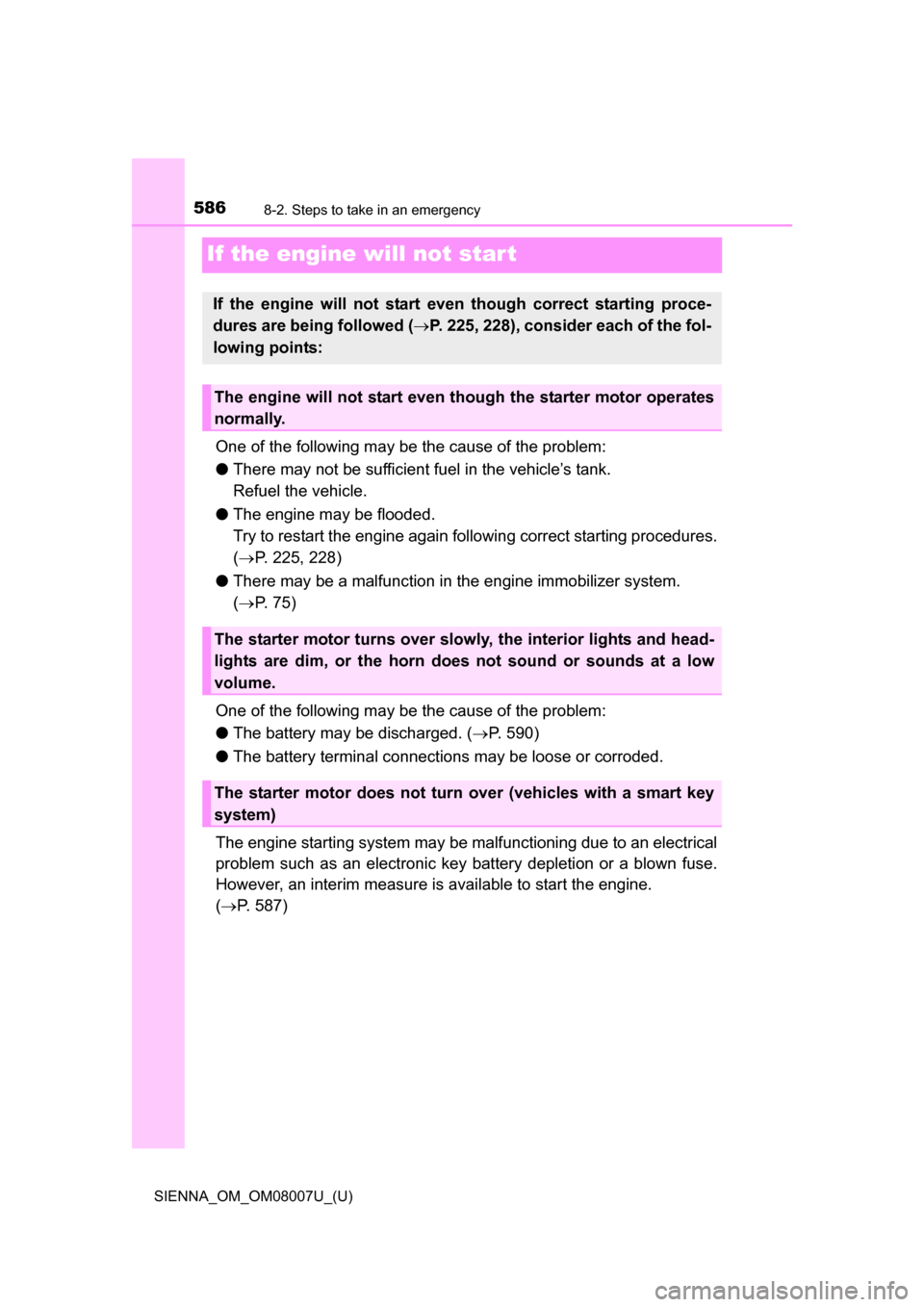
586
SIENNA_OM_OM08007U_(U)
8-2. Steps to take in an emergency
If the engine will not start
One of the following may be the cause of the problem:
●There may not be sufficient fuel in the vehicle’s tank.
Refuel the vehicle.
● The engine may be flooded.
Try to restart the engine again following correct starting procedures.
( P. 225, 228)
● There may be a malfunction in the engine immobilizer system.
( P. 75)
One of the following may be the cause of the problem:
● The battery may be discharged. ( P. 590)
● The battery terminal connections may be loose or corroded.
The engine starting system may be malfunctioning due to an electrical
problem such as an electronic key battery depletion or a blown fuse.
However, an interim measure is available to start the engine.
( P. 587)
If the engine will not start even though correct starting proce-
dures are being followed ( P. 225, 228), consider each of the fol-
lowing points:
The engine will not start even though the starter motor operates
normally.
The starter motor turns over slowly, the interior lights and head-
lights are dim, or the horn does not sound or sounds at a low
volume.
The starter motor does not turn over (vehicles with a smart key
system)
Page 587 of 672
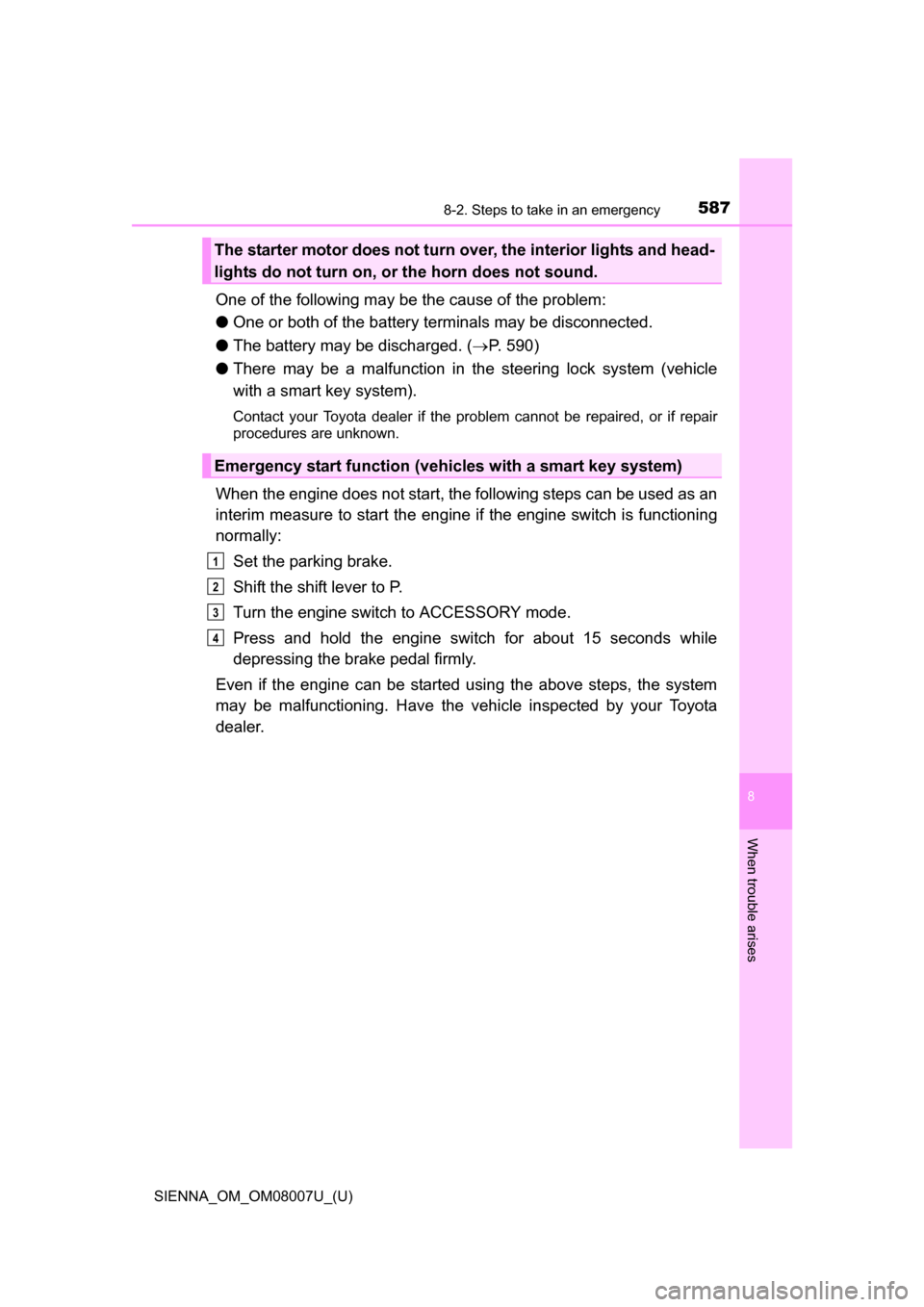
5878-2. Steps to take in an emergency
SIENNA_OM_OM08007U_(U)
8
When trouble arises
One of the following may be the cause of the problem:
●One or both of the battery terminals may be disconnected.
● The battery may be discharged. ( P. 590)
● There may be a malfunction in the steering lock system (vehicle
with a smart key system).
Contact your Toyota dealer if the problem cannot be repaired, or if repair
procedures are unknown.
When the engine does not start, the following steps can be used as an
interim measure to start the engine if the engine switch is functioning
normally:
Set the parking brake.
Shift the shift lever to P.
Turn the engine switch to ACCESSORY mode.
Press and hold the engine switch for about 15 seconds while
depressing the brake pedal firmly.
Even if the engine can be started using the above steps, the system
may be malfunctioning. Have the v ehicle inspected by your Toyota
dealer.
The starter motor does not turn ov er, the interior lights and head-
lights do not turn on, or the horn does not sound.
Emergency start function (vehicles with a smart key system)
1
2
3
4
Page 591 of 672
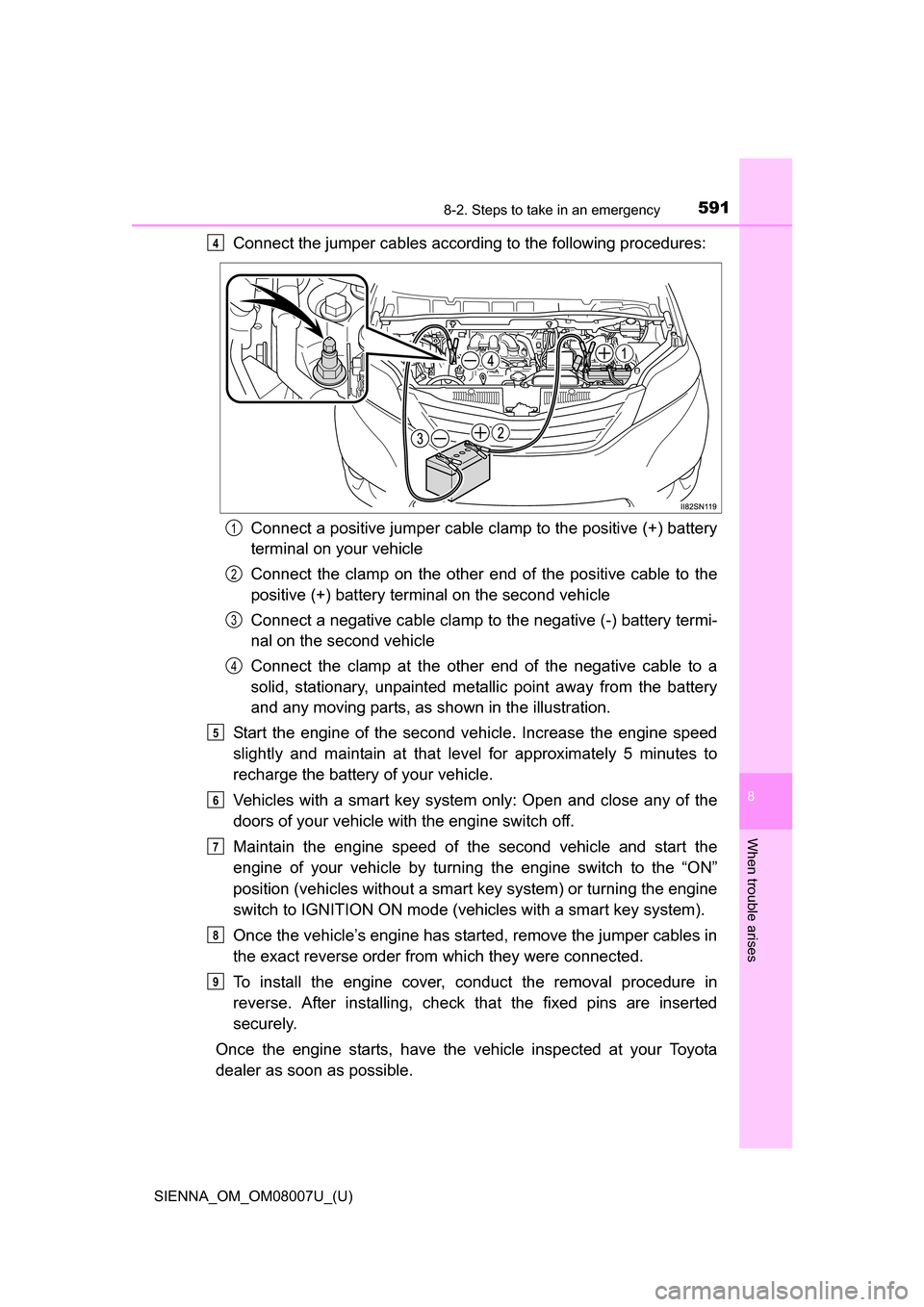
5918-2. Steps to take in an emergency
SIENNA_OM_OM08007U_(U)
8
When trouble arises
Connect the jumper cables according to the following procedures:Connect a positive jumper cable clamp to the positive (+) battery
terminal on your vehicle
Connect the clamp on the other e nd of the positive cable to the
positive (+) battery terminal on the second vehicle
Connect a negative cable clamp to the negative (-) battery termi-
nal on the second vehicle
Connect the clamp at the other end of the negative cable to a
solid, stationary, unpainted metallic point away from the battery
and any moving parts, as shown in the illustration.
Start the engine of the second vehicle. Increase the engine speed
slightly and maintain at that le vel for approximately 5 minutes to
recharge the batter y of your vehicle.
Vehicles with a smart key system only: Open and close any of the
doors of your vehicle with the engine switch off.
Maintain the engine speed of t he second vehicle and start the
engine of your vehicle by turni ng the engine switch to the “ON”
position (vehicles without a smart key system) or turning the engine
switch to IGNITION ON mode (v ehicles with a smart key system).
Once the vehicle’s engine has started, remove the jumper cables in
the exact reverse order from which they were connected.
To install the engine cover, conduct the removal procedure in
reverse. After installing, check that the fixed pins are inserted
securely.
Once the engine starts, have the vehicle inspected at your Toyota
dealer as soon as possible.4
1
2
3
4
5
6
7
8
9
Page 592 of 672
5928-2. Steps to take in an emergency
SIENNA_OM_OM08007U_(U)
■Starting the engine when the battery is discharged
The engine cannot be started by push-starting.
■ To prevent battery discharge
●Turn off the headlights and the audio system while the engine is off.
● Turn off any unnecessary electrical components when the vehicle is running
at a low speed for an extended period, such as in heavy traffic.
■ When the battery is removed or discharged
●The power sliding door (if equipped) must be initialized. ( P. 128)
● The power back door (if equipped) must be initialized. ( P. 138)
■ Charging the battery
The electricity stored in the battery will discharge gradually even when the
vehicle is not in use, due to natural discharge and the draining effects of cer-
tain electrical appliances. If the vehicle is left for a long time, the battery may
discharge, and the engine may be unable to start. (The battery recharges
automatically during driving.)
Page 593 of 672

5938-2. Steps to take in an emergency
SIENNA_OM_OM08007U_(U)
8
When trouble arises
WARNING
■Avoiding battery fires or explosions
Observe the following precautions to prevent accidentally igniting the flam-
mable gas that may be emitted from the battery:
●Make sure the jumper cable is connected to the correct terminal and that it
is not unintentionally in contact with any other than the intended terminal.
● Do not allow the other end of the jumper cable connected to the “+” termi-
nal to come into contact with any other parts or metal surfaces in the area,
such as brackets or unpainted metal.
● Do not allow the + and - clamps of the jumper cables to come into contact
with each other.
● Do not smoke, use matches, cigarette lighters or allow open flame near
the battery.
■ Battery precautions
The battery contains poisonous and corrosive acidic electrolyte, while
related parts contain lead and lead compounds. Observe the following pre-
cautions when handling the battery:
●When working with the battery, always wear safety glasses and take care
not to allow any battery fluids (acid) to come into contact with skin, clothing
or the vehicle body.
● Do not lean over the battery.
● In the event that battery fluid comes into contact with the skin or eyes,
immediately wash the affected area with water and seek medical attention.
Place a wet sponge or cloth over the affected area until medical attention
can be received.
● Always wash your hands after handling the battery support, terminals, and
other battery-related parts.
● Do not allow children near the battery.
NOTICE
■When handling jumper cables
When connecting the jumper cables, ensure that they do not become entan-
gled in the cooling fans or belt.
■ To prevent damage to the engine cover
●When removing the cover, make sure that you pull the cover towards you
after lifting the front edge to remove the fixed pins.
● When installing the cover, do not force the cover or subject it to strong
shocks.
Page 604 of 672
604
SIENNA_OM_OM08007U_(U)
9-1. Specifications
Cooling system
Capacity
Without towing package
12.2 qt. (11.5 L, 10.1 Imp.qt.)
With towing package
12.5 qt. (11.8 L, 10.4 Imp.qt.)
Coolant type Use either of the following.
• “Toyota Super Long Life Coolant”
• A similar high-quality ethylene glycol-basednon-silicate, non-amine, non-nitrite, and non-
borate coolant with long-life hybrid organic
acid technology
Do not use plain water alone.
Ignition system
Spark plug
Make
Gap DENSO FK20HBR8
0.03 in. (0.8 mm)
NOTICE
■
Iridium-tipped spark plugs
Use only iridium-tipped spark plugs. Do not adjust spark plug gap.
Electrical system
Battery
Open voltage* at
68 F (20 C): 12.3 V or more
If the voltage is lower than the standard value,
charge the battery.
(
*: Voltage checked 20 minutes after the engine
and all the lights turned off)
Charging rates 5 A max.
Page 608 of 672
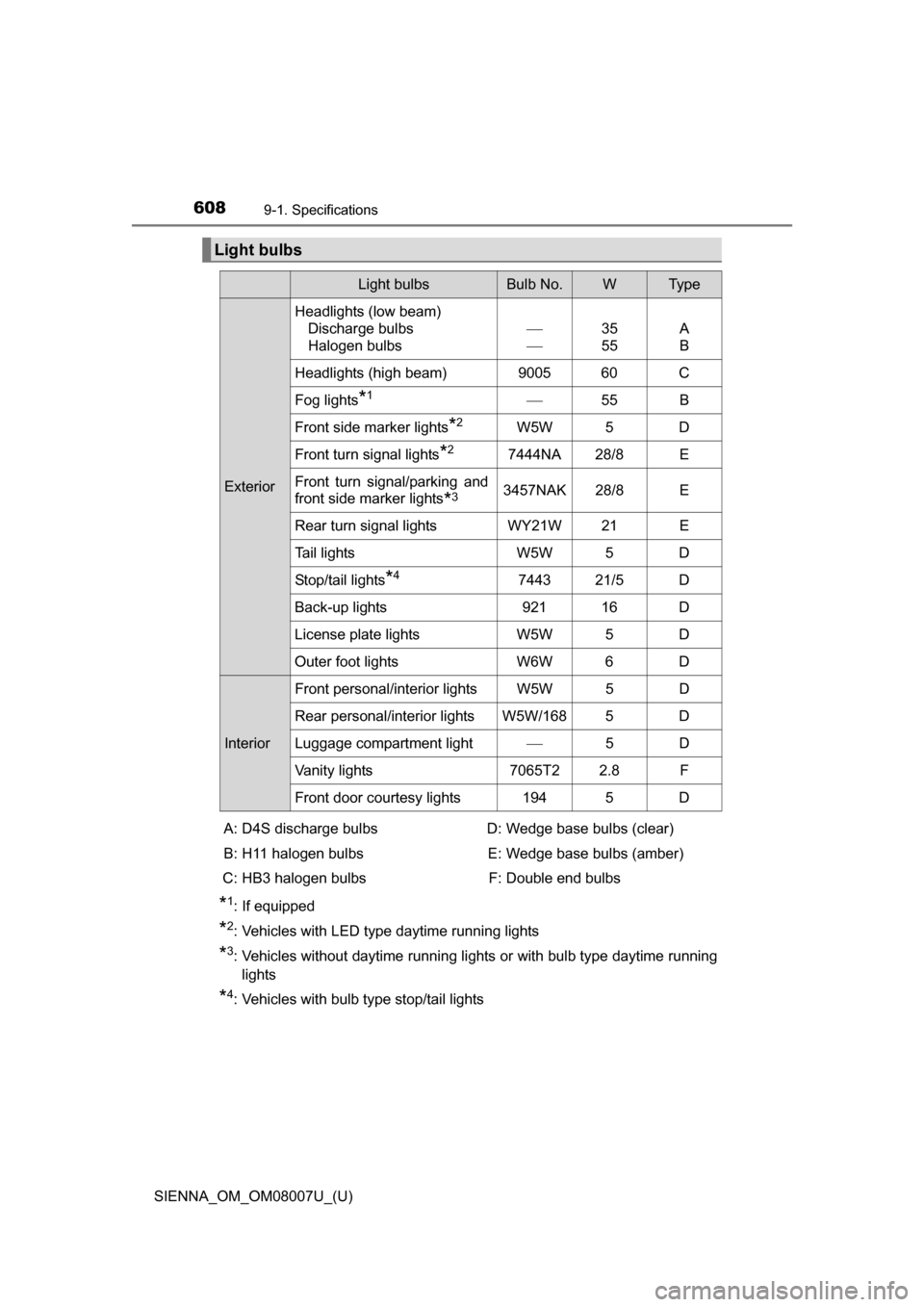
608
SIENNA_OM_OM08007U_(U)
9-1. Specifications
Light bulbs
Light bulbsBulb No.WTy p e
ExteriorHeadlights (low beam)
Discharge bulbs
Halogen bulbs
35
55 A
B
Headlights (high beam) 9005 60 C
Fog lights
*1 55 B
Front side marker lights
*2W5W 5 D
Front turn signal lights
*27444NA 28/8 E
Front turn signal/parking and
front side marker lights
*33457NAK 28/8 E
Rear turn signal lights WY21W 21 E
Tail lights W5W 5 D
Stop/tail lights
*47443 21/5 D
Back-up lights 921 16 D
License plate lights W5W 5 D
Outer foot lights W6W 6 D
InteriorFront personal/interior lights W5W 5 D
Rear personal/interior lights W5W/168 5 D
Luggage compartment light
5D
Vanity lights 7065T2 2.8 F
Front door courtesy lights 194 5 D
A: D4S discharge bulbs
B: H11 halogen bulbs
C: HB3 halogen bulbs D: Wedge base bulbs (clear)
E: Wedge base bulbs (amber) F: Double end bulbs
*1: If equipped
*2: Vehicles with LED type daytime running lights
*3: Vehicles without daytime running li ghts or with bulb type daytime running
lights
*4: Vehicles with bulb type stop/tail lights
Page 610 of 672
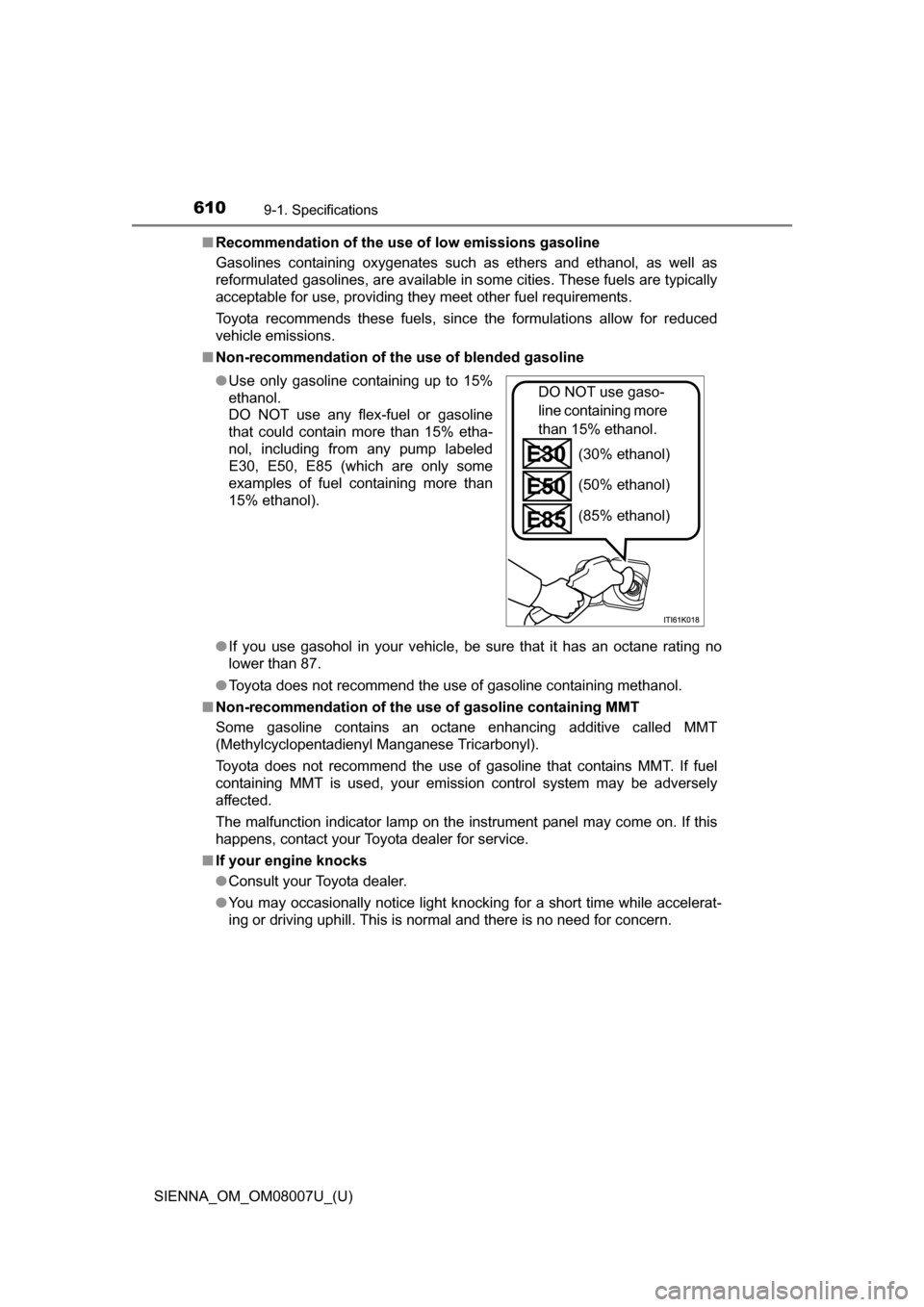
610
SIENNA_OM_OM08007U_(U)
9-1. Specifications
■Recommendation of the use of low emissions gasoline
Gasolines containing oxygenates such as ethers and ethanol, as well as
reformulated gasolines, are available in some cities. These fuels are typically
acceptable for use, providing they meet other fuel requirements.
Toyota recommends these fuels, since the formulations allow for reduced
vehicle emissions.
■ Non-recommendation of the use of blended gasoline
●If you use gasohol in your vehicle, be sure that it has an octane rating no
lower than 87.
● Toyota does not recommend the use of gasoline containing methanol.
■ Non-recommendation of the use of gasoline containing MMT
Some gasoline contains an octane enhancing additive called MMT
(Methylcyclopentadienyl Manganese Tricarbonyl).
Toyota does not recommend the use of gasoline that contains MMT. If fuel
containing MMT is used, your emission control system may be adversely
affected.
The malfunction indicator lamp on the instrument panel may come on. If this
happens, contact your Toyota dealer for service.
■ If your engine knocks
●Consult your Toyota dealer.
● You may occasionally notice light knocking for a short time while accelerat-
ing or driving uphill. This is normal and there is no need for concern.
●
Use only gasoline containing up to 15%
ethanol.
DO NOT use any flex-fuel or gasoline
that could contain more than 15% etha-
nol, including from any pump labeled
E30, E50, E85 (which are only some
examples of fuel containing more than
15% ethanol).
DO NOT use gaso-
line containing more
than 15% ethanol.
(30% ethanol)
(50% ethanol)
(85% ethanol)